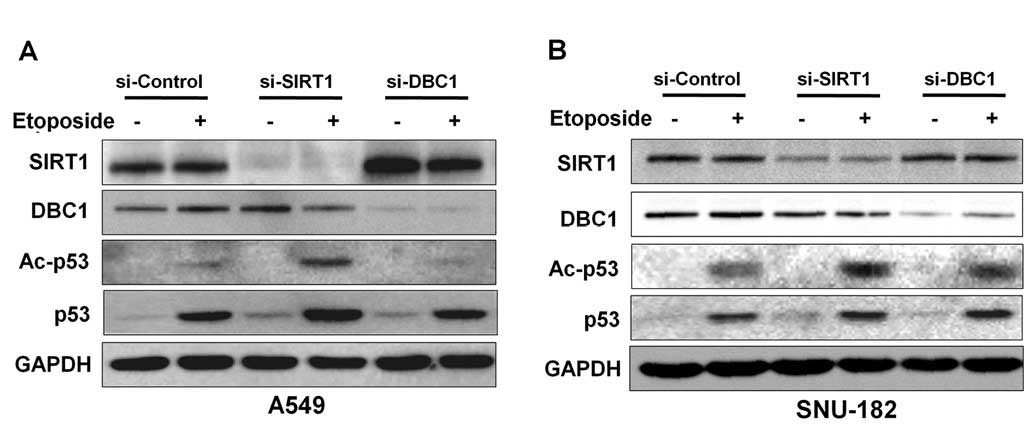|
1.
|
A JemalF BrayMM CenterJ FerlayE WardD
FormanGlobal cancer statisticsCA Cancer J
Clin616990201110.3322/caac.20107
|
|
2.
|
S WhittakerR MaraisAX ZhuThe role of
signaling pathways in the development and treatment of
hepatocellular
carcinomaOncogene2949895005201010.1038/onc.2010.23620639898
|
|
3.
|
Y ItoY SasakiM HorimotoActivation of
mitogen-activated protein kinases/extracellular signal-regulated
kinases in human
hepatocellularcarcinomaHepatology27951958199810.1002/hep.5102704099537433
|
|
4.
|
CM WongST FanIO NgBeta-catenin mutation
and overexpression in hepatocellular carcinoma: clinicopathologic
and prognostic
significanceCancer92136145200110.1002/1097-0142(20010701)92:1%3C136::AID-CNCR1301%3E3.0.CO;2-R11443619
|
|
5.
|
M HamaguchiJL MethC von KlitzingDBC2, a
candidate for a tumor suppressor gene involved in breast cancerProc
Natl Acad Sci USA991364713652200210.1073/pnas.212516099
|
|
6.
|
JE KimJ ChenZ LouDBC1 is a negative
regulator of
SIRT1Nature451583586200810.1038/nature0650018235501
|
|
7.
|
W ZhaoJP KruseY TangSY JungJ QinW
GuNegative regulation of the deacetylase SIRT1 by
DBC1Nature451587590200810.1038/nature0651518235502
|
|
8.
|
AM TrauernichtSJ KimNH KimTG
BoyerModulation of estrogen receptor α protein level and survival
function by DBC-1Mol Endocrinol21152615362007
|
|
9.
|
J FuJ JiangJ LiDeleted in breast cancer 1,
a novel androgen receptor (AR) coactivator that promotes AR
DNA-binding activityJ Biol
Chem28468326840200910.1074/jbc.M80898820019126541
|
|
10.
|
S GarapatyCF XuP TrojerMA MahajanTA
NeubertHH SamuelsIdentification and characterization of a novel
nuclear protein complex involved in nuclear hormone
receptor-mediated gene regulationJ Biol
Chem28475427552200910.1074/jbc.M80587220019131338
|
|
11.
|
Z LiL ChenN KabraC WangJ FangJ
ChenInhibition of SUV39H1 methyltransferase activity by DBC1J Biol
Chem2841036110366200910.1074/jbc.M90095620019218236
|
|
12.
|
CC ChiniC EscandeV NinEN ChiniHDAC3 is
negatively regulated by the nuclear protein DBC1J Biol
Chem2854083040837201010.1074/jbc.M110.15327021030595
|
|
13.
|
DM HuffmanWE GrizzleMM BammanSIRT1 is
significantly elevated in mouse and human prostate cancerCancer
Res6766126618200710.1158/0008-5472.CAN-07-008517638871
|
|
14.
|
KY JangKS KimSH HwangExpression and
prognostic significance of SIRT1 in ovarian epithelial
tumoursPathology41366371200910.1080/0031302090288445119404850
|
|
15.
|
EJ ChaSJ NohKS KwonExpression of DBC1 and
SIRT1 is associated with poor prognosis of gastric carcinomaClin
Cancer Res1544534459200910.1158/1078-0432.CCR-08-332919509139
|
|
16.
|
W StunkelBK PehYC TanFunction of the SIRT1
protein deacetylase in cancerBiotechnol
J213601368200710.1002/biot.20070008717806102
|
|
17.
|
J ChenB ZhangN WongSirtuin 1 is
upregulated in a subset of hepatocellular carcinomas where it is
essential for telomere maintenance and tumor cell growthCancer
Res7141384149201110.1158/0008-5472.CAN-10-427421527554
|
|
18.
|
C EscandeCC ChiniV NinDeleted in breast
cancer-1 regulates SIRT1 activity and contributes to high-fat
diet-induced liver steatosis in miceJ Clin
Invest120545558201010.1172/JCI3931920071779
|
|
19.
|
JE KimZ LouJ ChenInteractions between DBC1
and SIRT 1 are deregulated in breast cancer cellsCell
Cycle837843785200910.4161/cc.8.22.1005519855164
|
|
20.
|
E Ji YuSH KimK HeoCY OuMR StallcupJH
KimReciprocal roles of DBC1 and SIRT1 in regulating estrogen
receptor α activity and co-activator synergyNucleic Acids
Res3969326943201121596782
|
|
21.
|
A MenssenP HydbringK KapelleThe c-MYC
oncoprotein, the NAMPT enzyme, the SIRT1-inhibitor DBC1, and the
SIRT1 deacetylase form a positive feedback loopProc Natl Acad Sci
USA201122190494
|
|
22.
|
R SundararajanG ChenC MukherjeeE
WhiteCaspase-dependent processing activates the proapoptotic
activity of deleted in breast cancer-1 during tumor necrosis
factor-α-mediated death signalingOncogene2449084920200515824730
|
|
23.
|
H LeeKR KimSJ NohExpression of DBC1 and
SIRT1 is associated with poor prognosis for breast carcinomaHum
Pathol42204213201010.1016/j.humpath.2010.05.02321056897
|
|
24.
|
EJ KimJH KhoMR KangSJ UmActive regulator
of SIRT1 cooperates with SIRT1 and facilitates suppression of p53
activityMol
Cell28277290200710.1016/j.molcel.2007.08.03017964266
|
|
25.
|
H KangJW JungMK KimJH ChungCK2 is the
regulator of SIRT1 substrate-binding affinity, deacetylase activity
and cellular response to DNA-damagePLoS
One4e6611200910.1371/journal.pone.000661119680552
|
|
26.
|
Y YangW FuJ ChenSIRT1 sumoylation
regulates its deacetylase activity and cellular response to
genotoxic stressNat Cell
Biol912531262200710.1038/ncb164517934453
|
|
27.
|
L McKendrickD MilneD MeekProtein kinase
CK2-dependent regulation of p53 function: evidence that the
phosphorylation status of the serine 386 (CK2) site of p53 is
constitutive and stableMol Cell
Biochem191187199199910.1023/A:1006854109926
|
|
28.
|
R BennettY PanJ ChristianT HuiWS May JrThe
RAX/PACT-PKR stress response pathway promotes p53 sumoylation and
activation, leading to G1 arrestCell
Cycle11407417201210.4161/cc.11.2.1899922214662
|
|
29.
|
JF ReidM GariboldiV SokolovaIntegrative
approach for prioritizing cancer genes in sporadic colon
cancerGenes Chromosomes
Cancer48953962200910.1002/gcc.2069719672874
|














